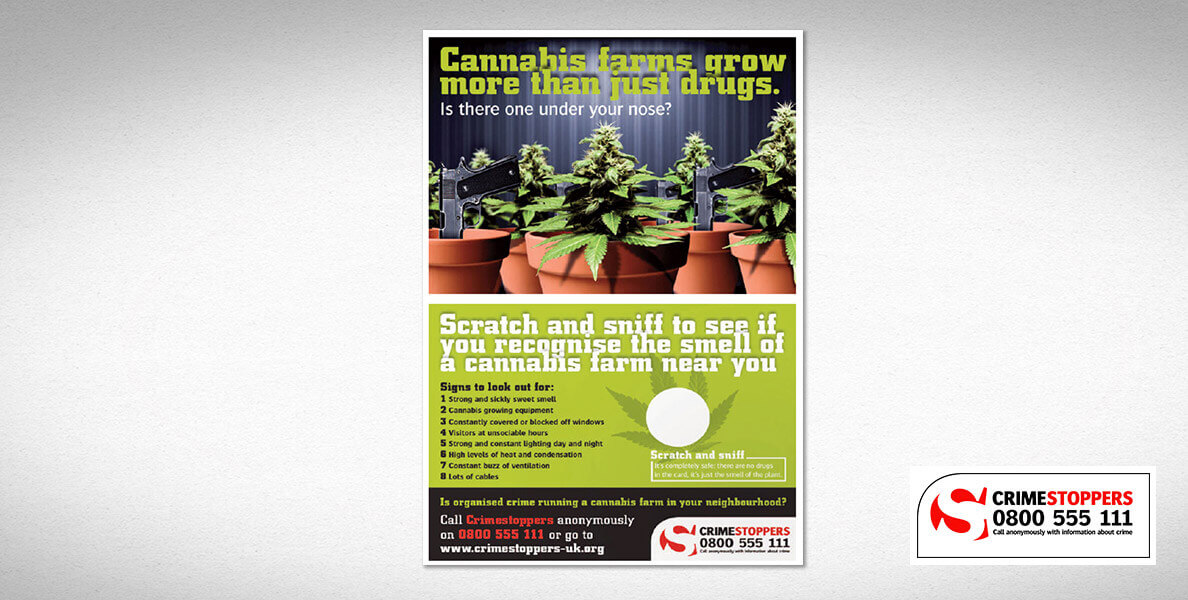Crimestoppers


Background
Cannabis was seen by many as the more acceptable side of recreational drugs and this attitude had allowed cannabis farms and dealing to thrive in many deprived inner city areas.
In 2011/12 there had been a 15% increase in cannabis farms in the UK. And with the police seizing over one million plants, with an estimated value of £200 million over the previous two years, it was clear that the problem was getting worse.
An urban cannabis farm can be in a single room like a loft of basement, or a complete house, flat or warehouse – typically on inner city housing estates. But cannabis farms require a significant amount of electricity to light and heat the growing rooms 24 hours a day. This electricity is rarely paid for - usually syphoned directly off the national grid. Not only can the makeshift cabling be a serious fire risk; it is also "energy theft". Suppliers and Distribution Network Operators (DNOs) report over 25,000 energy thefts per year. The total value of related energy theft is unclear but OFGEM reports that it could be around £400m per year.
Furthermore, there was evidence that ‘organised crime’ was behind the majority of cannabis farms – undoubtedly bringing violence and other crime to the communities.
The serious social and economic consequences of this relaxed attitude in the communities had never been communicated – however Crimestoppers knew that encouraging residents within the targeted urban communities to report any crime – including cannabis farms - had always been fraught with difficulties.
With a limited budget, the charity needed a highly targeted campaign that would reach residents living on, or near, estates where cannabis farms were usually located and compel them to report any farms in their area.
Solution
Crimestoppers believed that the message that held the most weight amongst all ages – above electricity theft, danger of fire from dodgy wiring or the threat of children being sold drugs – was the threat of violent crime by gangs connected to organised crime. This became the heart of their messaging, and the heart of their targeting approach.
Working closely with 13 regional police forces across the UK, Crimestoppers identified key urban areas with high crime levels near where cannabis farms were usually located.
Direct mail was chosen as the ideal medium to get their message into these highly targeted areas. Read in the privacy of their own home, the recipients could learn about the harm that farms could cause to their community. And, unlike a poster or press-ad, direct mail would have the space to communicate all the telltale signs that a factory was operating in their community – even next door. But what would make someone engage in the content of a direct mail piece and then talk about the issues and the signs with their neighbours? And how could Crimestoppers use the issues, more widely discussed in the national and local press, to raise general awareness?
Based on the success of a mailing by the Dutch police that used cannabis slurry to replicate the distinctive smell of cannabis but didn’t contain any THC’s (so was safe), Crimestoppers created a ‘scratch and sniff’ cannabis mailing. Once scratched it would help residents recognise the smell of a cannabis farm on their doorstep.
The creative had to take the public appeal beyond mild curiosity of a ‘scratch and sniff’ gimmick to an impactful message that associated cannabis cultivation with violent crime. Mailed to 220,000 homes, the message was simple and clear: ‘Cannabis farms grow more than just drugs’.
By engaging journalists in both the message and the mechanic, Crimestoppers knew they would get greater coverage for their limited budget. Regional supporters and volunteers were also used to spread the reach through social media and e-shots.
Results
The scratch and sniff campaign was Crimestoppers’ most successful in their 25 year history.
Telephone and online reports to Crimestoppers about 'Drugs manufacture and cultivation' increased by 63% over the two weeks immediately after launch and 40% over the following month.
There were an estimated 1500 more drugs related reports than in the same two-month period in the previous year.
Based on information from Crimestoppers and other intelligence, the Metropolitan Police raided and closed 34 cannabis farms, made 387 arrests, seized plants with an estimated street value of £2.1m and an undisclosed number of firearms.
Merseyside Police received a 56% increase in intelligence logs in the first month of the campaign and least 25 cannabis farms were identified as a result.
West Yorkshire Police and West Midlands Police reported a 94% and 77% increase in intelligence logs respectively.
As well as identifying and closing local cannabis farms, the campaign delivered national reach and impact.
In total, 435 different items of local, national and even international pieces were in the media in the two months after the launch - reaching millions of people.
Crimestoppers' Twitter followers increased by 97% from the week before the campaign launched and 1735 campaign related comments were posted on their Facebook page. And traffic to Crimestoppers' website increased by 24% during the week of launch.
Source: Crimestoppers, Design Business Association Bronze Design Effectiveness Awards




